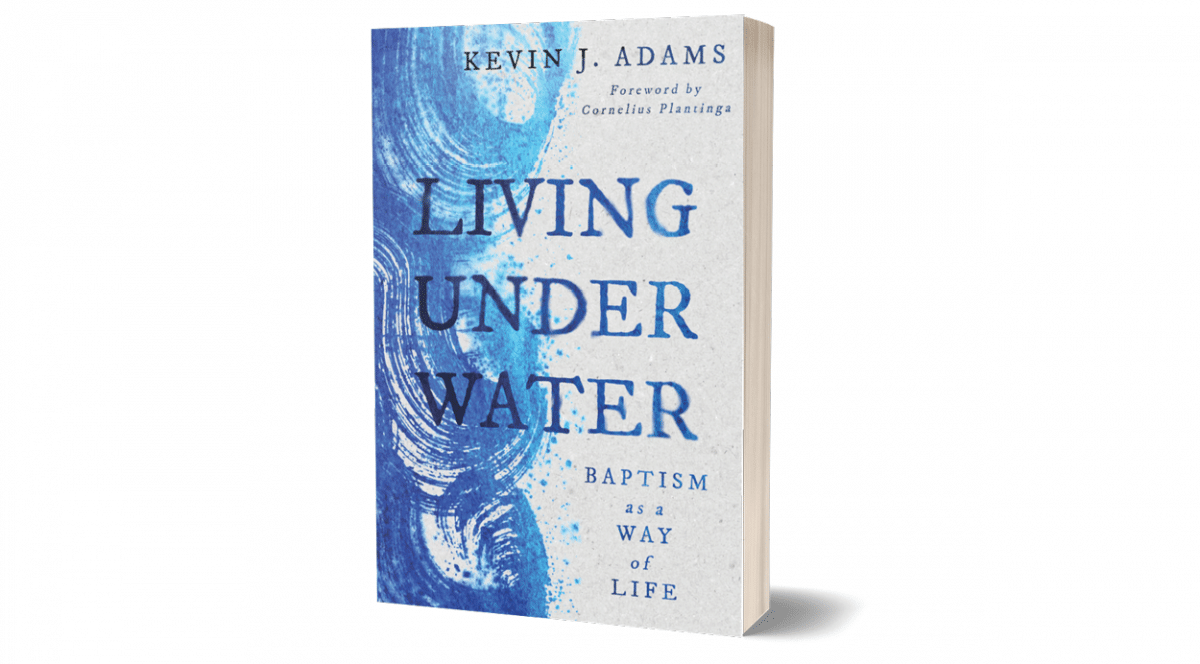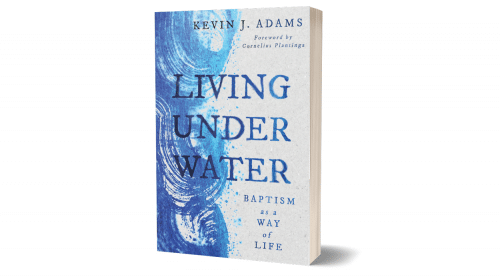
LIVING UNDER WATER: Baptism as a Way of Life. By Kevin J. Adams. Foreword by Cornelius Plantinga. Grand Rapids: William B. Eerdmans Publishing Company, 2022.
I was baptized the day I was born by nurses at the Catholic hospital where I was born. Because I had a difficult birth the nurses wanted to make sure I was eternally covered in case things didn’t work out for me. My parents later took me to their Episcopal Church in the months following my birth and again had me baptized (sprinkled). That should have been enough but during my teen years, I decided to get immersed in a creek by my youth pastor because I wasn’t sure that my earlier baptisms (and my confirmation in the Episcopal Church) were efficacious. Besides my own baptisms, as a pastor, I’ve baptized a number of people, including my son. Being part of an immersionist tradition that baptizes on confession of faith, all the baptisms I’ve performed have been in that mode. Oh, and I was fired from a teaching position because my view of the essential nature of baptism came into question. In other words, I’ve had some experience with the waters of baptism.

Robert D. Cornwall
It is with this background that I took up the review copy sent to me by the publisher of Kevin Adams’ book Living Under Water: Baptism as a Way of Life. Adams is the senior pastor of Granite Springs Church in greater Sacramento, California, and a minister within the Christian Reformed Church. Therefore, he serves in a tradition that practices infant baptism. While this is true, in his ministry he sprinkles and immerses both the young (read infant) and the old (read adults). Whether it’s immersion or sprinkling Adams demonstrates a strong commitment to baptism as a marker of being all in when it comes to being a Christian. He writes this book hoping that it will help Christians answer the question, why baptism? The focus here is not on the mode of baptism (immersion or sprinkling) or even timing (adult or infant), but rather on meaning and purpose. The book emerged out of conversations about the meaning of baptism undertaken within the church he serves.
In Living Under Water, Adams mixes stories about the persons he’s baptized with explorations of biblical and historical texts. It is the stories that most shape his theology and the book. He notes that while the baptismal experiences of members of his congregation were diverse, by discussing them they found unity among themselves. It is a unity, he tells us, that bound the participants in the conversation not only to themselves but to the global church, together with the saints and believers of the past, including those whose stories are told in the Bible. He writes that “when we approach baptism through story, we find, to our great relief and delight, that our truest identity isn’t dependent on our mode of baptism.” That is because “it is a gift we receive” (p. 7). While Adams describes this as being a book about baptism, it is, more specifically, a book that speaks to the question of identity that flows out of baptism. It is a question that many Christians, including myself, have asked. Now that I’ve been baptized, what does that mean?
Adams divides the book into four parts. Part One focuses on “Baptismal Identity.” Part Two looks at “Baptismal Liturgy for Life.” Part Three discusses what he calls “Baptismal Abuse.” This section might be the most important section because the four chapters in the section look at ways in which baptism has been misused to oppress and abuse. Finally, Part Four speaks of “Baptismal Hope.” In the end, Adams invites us to develop a “Baptismal Imagination.”
In his opening chapter, Adams introduces us to the conversation about baptismal identity by telling several baptismal stories, including the author’s own baptism experience at age ten days, along with the stories of a man baptized in a waterfall by a topless woman, an experience that his friend ultimately decided was not true baptism, so he was baptized a second time in a more traditional setting. Nevertheless, it was that rather odd experience that started the man on his Christian journey. So, we never know how the journey will begin. The important piece, when it comes to the script of baptism, is claiming the generative power of baptism.
He moves on in a chapter titled “Kiddie-Pool Piety” by taking note of baptismal experiences that are high on enthusiasm but perhaps low on meaning. In this regard, he tells the story of an event he observed at a Christian college where he was teaching. It was filled with applause and shouts, but not much emphasis on meaning. In reflecting on this story, he suggests that some baptismal experiences might be rather light in their spiritual efficacy. In other words, baptism is just something we do without thinking about the implications, theological or otherwise. Adams concludes Part One with a chapter titled “Drowning in a Coffin.” In this chapter, he connects baptism with suffering. That is, to be baptized in the name of Jesus does not prevent us from experiencing suffering. Rather, since Jesus suffered, we may also expect to suffer if we’re baptized with his baptism.
In Part Two, Adams takes a look at the liturgical elements of baptism. He begins in chapter 4 with a chapter on Baptism as exorcism. He opens this chapter with the story of Delmar’s baptism in Oh Brother, Where Art Thou (one of my favorite baptism scenes). With that story in mind, Adams reminds us that in the ancient church and many current liturgies, part of the process of baptism includes the renunciation of evil. He writes that “to be baptized is to clearly and repeatedly turn our backs against evil and injustice and to denounce them wherever we see them” (p. 80). As Delmar realized, to be baptized involves a behavior change. In chapter five, Adams speaks of baptism as ordination. Here he begins with Jesus’ own baptism as the starting point of his ministry and then applies that ordination to our baptisms. In baptism, we are anointed with a missional identity that expresses divine grace to the world. Finally, in chapter 6 he speaks of baptismal clothes. That is, to be baptized is to be clothed with Christ. He draws here from the historic practice in the ancient church of giving new baptismal clothing after being baptized as a marker of one’s new identity in Christ.
Having addressed our baptismal identity through discussions of exorcism, ordination, and clothing, we move to Part Three. This might be the most important section of the book since Adams addresses ways in which baptism has been used in abusive ways. There is a chapter titled “Identity Politics,” which focuses on using baptism as an ethnic/national divider. As Adams notes, “Baptism reminds us that we—with our cultural experience and country of origin—are deeply included in this new community called the church.” (p. 121). At a time when Christian nationalism is on the rise, not only in the United States but around the world, this is a good reminder that to be in Christ transcends culture, nationality, and ethnicity. When religion is used in nationalistic ways, as we are seeing, it can be abusive and dangerous. Chapter 8 explores forced baptisms. He speaks to the practice of forcing people to be baptized against their will. Unfortunately, history is replete with examples of people being forced to be baptized, often at the point of the sword, and there continue to be examples of such baptisms. Chapter 9 is titled “Widow Waters,” and it focuses on baptism as spectacle or as a magic formula. He points to the practice of mass baptisms at Elevation Church where baptism is more show than meaning-making. Finally, Adams offers us a chapter on race and baptism. Here he tells the tragic and horrific story of how baptism was used abusively in support of slavery and other forms of racist efforts, such as apartheid. In other words, he speaks to how baptism has been used to reinforce white supremacy.
The final two chapters that make up Part Four offer us as the reader a word of hope. Adams speaks in chapter 11 about Healing Waters. He does so by bringing his own battle with Parkinson’s into the conversation. Baptism might not bring a cure to the body, but it can be healing in other ways. If chapter 11 speaks of healing the body, chapter twelve, the final chapter, speaks of the One Baptism. In other words, it speaks to another kind of healing, the healing of the Body of Christ through the unity of the Global Church. He speaks to the fact that not everyone accepts the baptisms of others as being valid. Therefore, baptism can be a marker of division. Nevertheless, baptism serves as an entry point into the global church. While Baptism often divides, it should be a sacrament/ordinance that unites us as members of the Body of Christ.
Living Under Water is not a doctrinal treatise, though it does speak to theology. Rather, it is a gathering of stories under different headings that invite us to explore and deepen our understanding of baptism. My theology of baptism might differ at points from his, but I appreciate what Kevin Adams does here in bringing different dimensions of baptism together in ways we rarely see. By engaging this book, perhaps we can gain a better sense of what baptism means so that we can live into its promise. We might even develop, as the title of the Epilogue suggests, a baptismal imagination. Therefore, we can imagine through baptism something that is powerful for the good of all.
This review originally appeared on BobCornwall.com.
Robert D. Cornwall is an ordained minister in the Christian Church (Disciples of Christ). Now retired from his ministry at Central Woodward Christian Church (Disciples of Christ) of Troy, Michigan, he serves as Minister-at-Large in Troy. He holds a Ph.D. in Historical Theology from Fuller Theological Seminary and is the author of numerous books including his latest books: Called to Bless: Finding Hope by Reclaiming Our Spiritual Roots (Cascade Books, 2021) and Unfettered Spirit: Spiritual Gifts for the New Great Awakening, 2nd Edition, (Energion Publications, 2021). His blog Ponderings on a Faith Journey can be found at www.bobcornwall.com.







